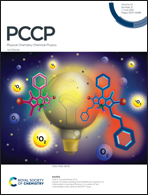Theoretical design of asymmetric A–D1A′D2–A type non-fullerene acceptors for organic solar cells†
Abstract
The acceptor in organic solar cells (OSCs) is of paramount importance for achieving a high photovoltaic performance. Based on the well-known non-fullerene acceptor Y6, we designed a set of asymmetric A–D1A′D2–A type new acceptors Y6–C, Y6–N, Y6–O, Y6–Se, and Y6–Si by substituting the two S atoms of one thieno[3,2-b]thiophene unit with C, N, O, Se, and Si atoms, respectively. The electronic, optical, and crystal properties of Y6 and the designed acceptors, as well as the interfacial charge-transfer (CT) mechanisms between the donor PM6 and the investigated acceptors have been systematically studied. It is found that the newly designed asymmetric acceptors possess suitable energy levels and strong interactions with the donor PM6. Importantly, the newly designed acceptors exhibit enhanced light harvesting ability and more CT states with larger oscillator strengths in the 40 lowest excited states. Among the multiple CT mechanisms, the direct excitation of CT states is found to be more favored in the case of PM6/newly designed acceptors than that of PM6/Y6. This work not only offers a set of promising acceptors superior to Y6, but also demonstrates that designing acceptors with asymmetric structure could be an effective strategy to improve the performance of OSCs.



 Please wait while we load your content...
Please wait while we load your content...